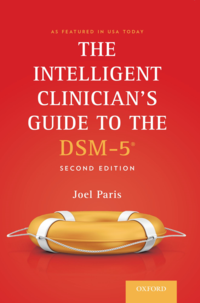Three new resources were recently added to the growing STAT!Ref Core Resources Collection for Psychiatry including Concurrent Treatment of PTSD and Substance Use Disorders Using Prolonged Exposure (COPE), Psychiatry and Clinical Neuroscience: A Primer and The Intelligent Clinician's Guide to the DSM-5®.
Concurrent Treatment of PTSD and Substance Use Disorders Using Prolonged Exposure (COPE) is a cognitive-behavioral psychotherapy program designed for patients who have posttraumatic stress disorder (PTSD) and a co-occurring alcohol or drug use disorder. COPE represents an integration of two evidence-based treatments: Prolonged Exposure (PE) therapy for PTSD and Relapse Prevention for substance use disorders.
Key Points:
- The COPE program combines two evidence-based treatments for patients with PTSD and Substance Use Disorders
- Brief, individual sessions can be applied to any type of traumatic event (e.g., rape, physical or sexual abuse, combat, natural disaster)
- Program is appropriate for men and women, as well as veterans and civilians
- COPE has demonstrated positive results for both alcohol and drug use disorders, and among people with childhood abuse as well as adult traumas
- The Therapist Guide is designed for clinicians on the front-line in community-based settings, as well as academic, hospital, and private practice settings
Clinicians who work with patients with PTSD and a co-occurring alcohol or drug-use disorder will benefit substantially from this resource. This would also be an excellent teaching tool for graduate-level courses such as advanced treatment techniques and psychotherapy.
Purchasers will want to bundle this resource with Oxford Handbook of Traumatic Stress Disorders and The Intelligent Clinician's Guide to the DSM-5®.

Psychiatry and Clinical Neuroscience: A Primer, examines recent developments in the field of network neuroscience and their potential impact on clinical psychiatry, including the way that psychiatrists are trained and interact with other medical specialties and mental health professionals.
Research in neuroscience is revolutionizing how we think about psychiatric diagnosis and treatment. Psychiatric disorders reflect dysfunction of the human mind and involve changes in cognition, emotion, and motivation. Understanding how the neural networks that underlie these mental functions become dysfunctional holds great promise for devising innovative approaches to diagnosis and treatment. Scientific progress is being driven, in part, by advances in human functional neuroimaging, which is being used to characterize the activity of specific brain circuits at rest and during the performance of specific tasks.
Moreover, advances in clinical neuroscience are being coupled with expanding knowledge about genetics and cellular and synaptic neuroscience. Taken together, these advancements offer the hope of much more mechanism-based approaches to treatment in the future. Better understanding of neural circuits also can provide the basis for innovative psychotherapeutic strategies that take advantage of brain plasticity for purposes of neurorehabilitation.
Overview
- first resource to examine how advances in network neuroscience are likely to impact the diagnosis and treatment of psychiatric disorders
- reflects an upcoming revolution in the field that has tremendous potential for improving the care of patients with these devastating illnesses
Purchasers will want to bundle this resource with Stahl's Essential Psychopharmacology, Advanced Practice Psychiatric Nursing and The Intelligent Clinician's Guide to the DSM-5®.
The Intelligent Clinician's Guide to the DSM-5® is the second edition of the widely-read resource first published in 2013. This second edition is thoroughly revised, and has several new chapters describing the response to the publication of the new manual, as well as suggestions on its use in clinical practice.
The Intelligent Clinician's Guide to the DSM-5®, Second Edition reviews the history of diagnosis in psychiatry, emphasizing the limitations for classification of our current lack of knowledge of the causes of most mental disorders. It emphasizes that, in the absence of biomarkers, current categories can only be considered provisional. It takes a critical look at schema for spectra and dimensionaliztion of diagnosis, examines the borders between normality and psychopathology, and discusses the problem of clinical utility. The resource has chapters on all the major diagnoses in psychiatry, in which the main problems of diagnosis are addressed, and in which all changes in DSM-5 are described.
Overview:
- Provides suggestions on the DSM-5's use in clinical practice
- Reviews the history of diagnosis in psychiatry
- Features chapters on all of the major diagnoses in psychiatry
New to this Edition:
- Contains new chapters on the response to the publication of DSM-5 and DSM-5 in practice
- Thoroughly revised material reflecting contemporary clinical practice today
Purchasers will want to bundle this resource with Psychiatric Nursing: Assessment, Care Plans and Medications and Goodwin and Guze's Psychiatric Diagnosis.
And, don't forget the new and comprehensive medical question bank product from STAT!Ref called BoardVitals. This interactive resource is a high-quality, affordable, effective and powerful board review tool for Psychiatry, Child Psychiatry and Psychiatry Vignettes. Click here to watch an informative video.
To talk to a STAT!Ref Team Member about these new resources or BoardVitals please feel free to call 800-901-5494 or fill out this form today.

